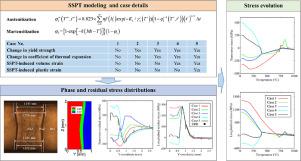International Journal of Mechanical Sciences ( IF 7.1 ) Pub Date : 2022-11-24 , DOI: 10.1016/j.ijmecsci.2022.107975 Jiajun Xu , Yu Huang , Youmin Rong

|
In this study, a thermal-metallurgical-mechanical (TMM) model was developed for finite element (FE) analysis in laser welding of ultra-high-strength steel (UHSS). The solid-state phase transformation (SSPT) model of austenization was improved by introducing a heating rate-dependent coefficient. Seven cases considering different SSPT-related effects (Case 1–5) and different austenization models (Case 5–7) were considered for the simulation of welding stress to study the stress evolution mechanism during welding. The effects include changes in the yield strength, coefficient of thermal expansion, volume strain, and plastic strain, all of which are induced by the SSPT. By comparing the predicted and measured partial austenitized zone (PAZ), it was found the proposed model had good accuracy for the ultra-high heating rates during laser welding. The predicted transverse/longitudinal welding stresses were also in good agreement with the measurements. The results show that each effect can dramatically change the evolution process and the final magnitude and sign of stress. For example, the SSPT-induced plastic strain always results in a plastic strain having the same sign as the stress, and, in return, gives rise to a decrease in the magnitude of stress. In addition, the SSPT-related effects are weakened when the austenization model underestimates the austenite fraction, leading to a larger error in the predicted stress.
中文翻译:

激光焊接过程中不同 SSPT 相关效应下的应力演化机制
在这项研究中,开发了一种热-冶金-机械 (TMM) 模型,用于超高强度钢 (UHSS) 激光焊接中的有限元 (FE) 分析。通过引入加热速率相关系数改进了奥氏体化的固态相变 (SSPT) 模型。七个考虑不同 SSPT 相关效应(案例 1-5)和不同奥氏体化模型(案例 5-7)的案例被用于焊接应力模拟,以研究焊接过程中的应力演化机制。这些影响包括屈服强度、热膨胀系数、体积应变和塑性应变的变化,所有这些都是由 SSPT 引起的。通过比较预测和测量的部分奥氏体化区 (PAZ),发现所提出的模型对于激光焊接过程中的超高加热速率具有良好的准确性。预测的横向/纵向焊接应力也与测量值非常吻合。结果表明,每种效应都可以显着改变演化过程以及最终的压力大小和符号。例如,SSPT 引起的塑性应变总是导致塑性应变与应力具有相同的符号,反过来,导致应力大小的减小。此外,当奥氏体化模型低估奥氏体分数时,SSPT 相关效应减弱,导致预测应力误差较大。SSPT 引起的塑性应变总是导致与应力符号相同的塑性应变,反过来,导致应力大小的减小。此外,当奥氏体化模型低估奥氏体分数时,SSPT 相关效应减弱,导致预测应力误差较大。SSPT 引起的塑性应变总是导致与应力符号相同的塑性应变,反过来,导致应力大小的减小。此外,当奥氏体化模型低估奥氏体分数时,SSPT 相关效应减弱,导致预测应力误差较大。









































 京公网安备 11010802027423号
京公网安备 11010802027423号